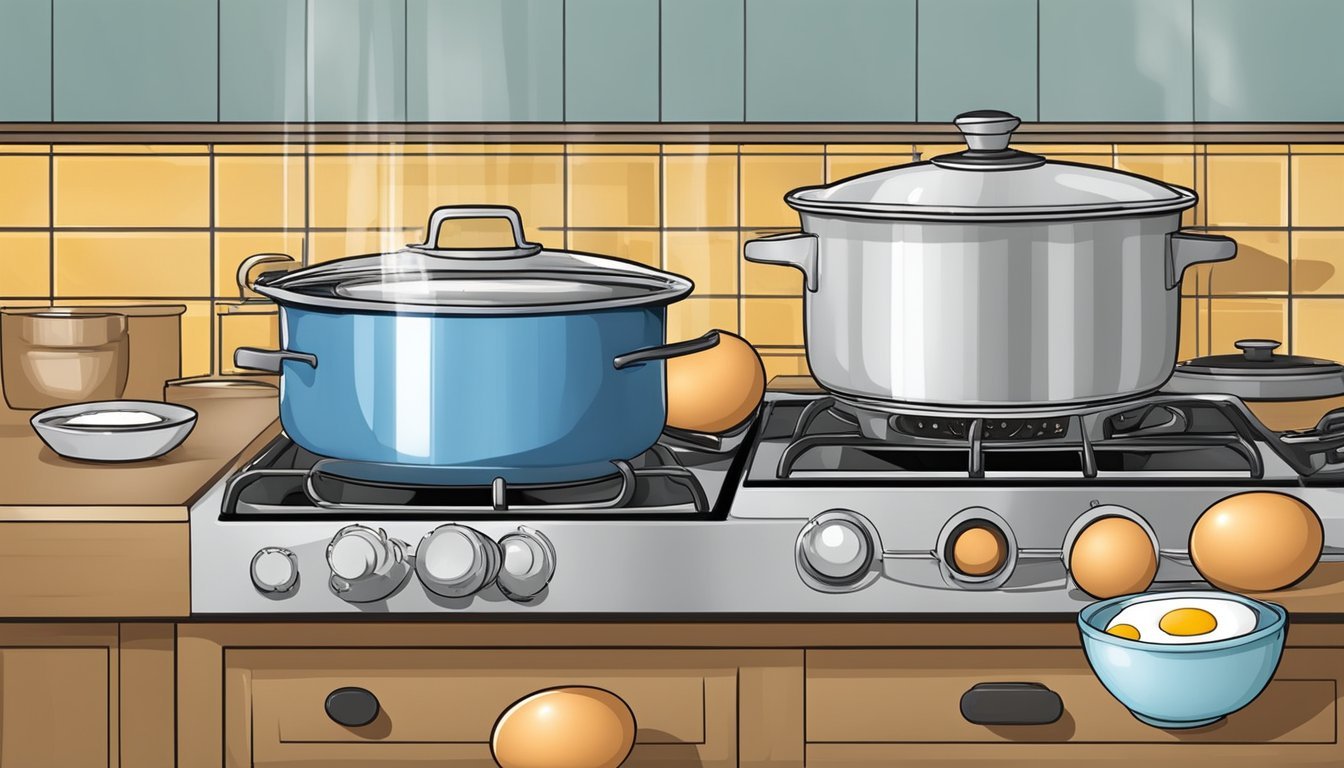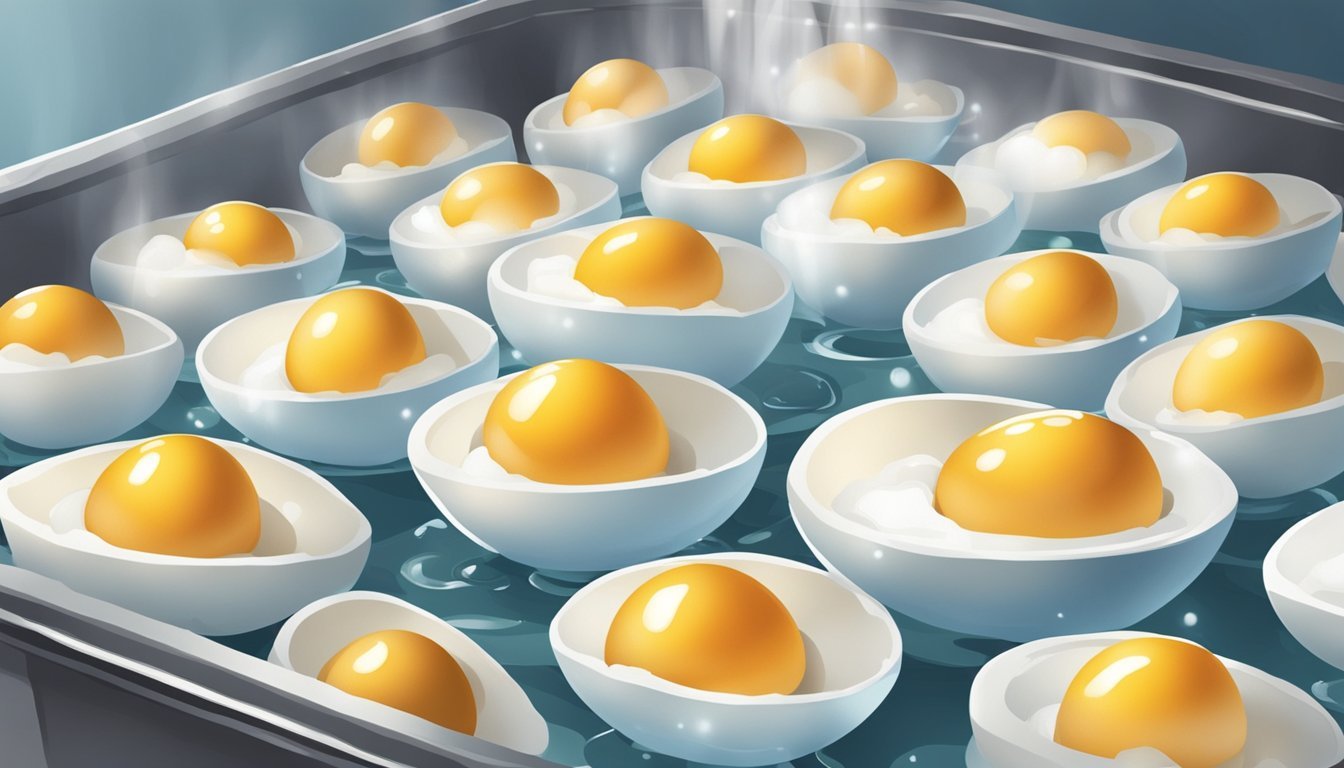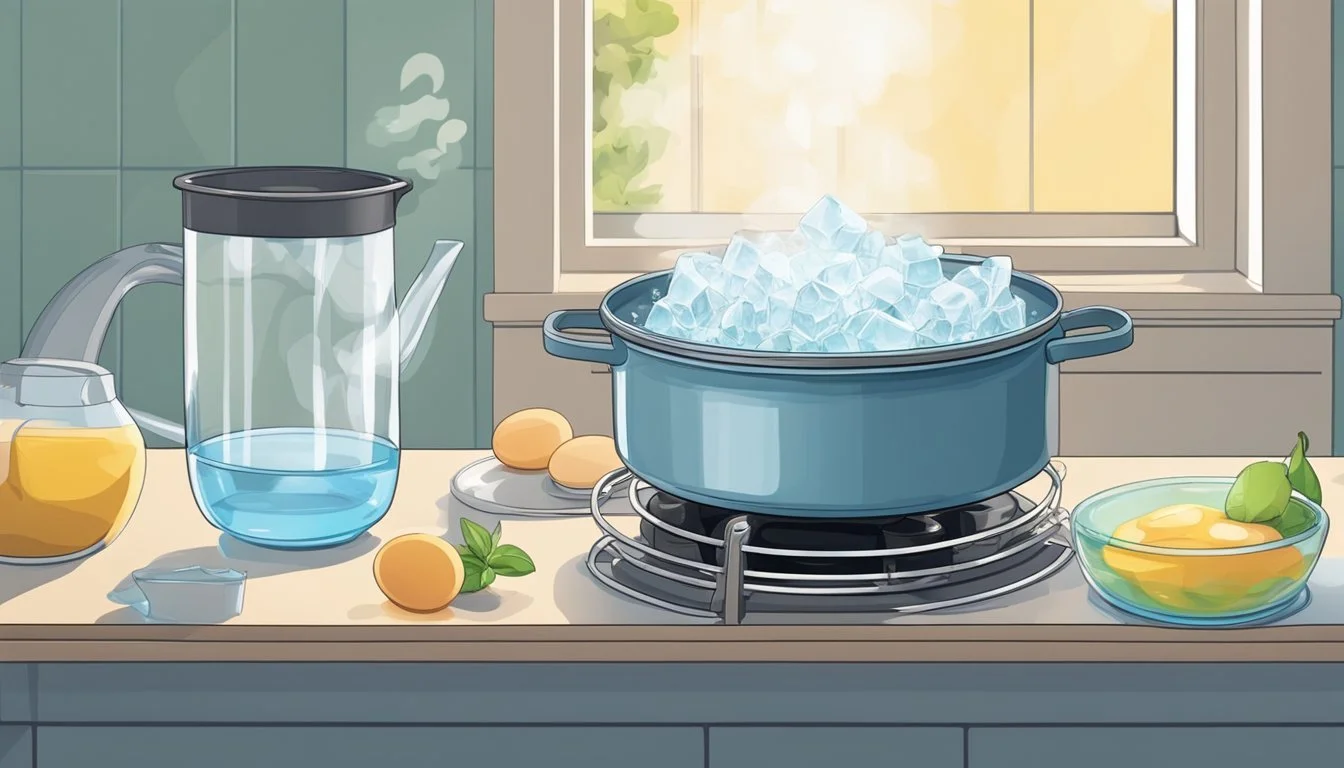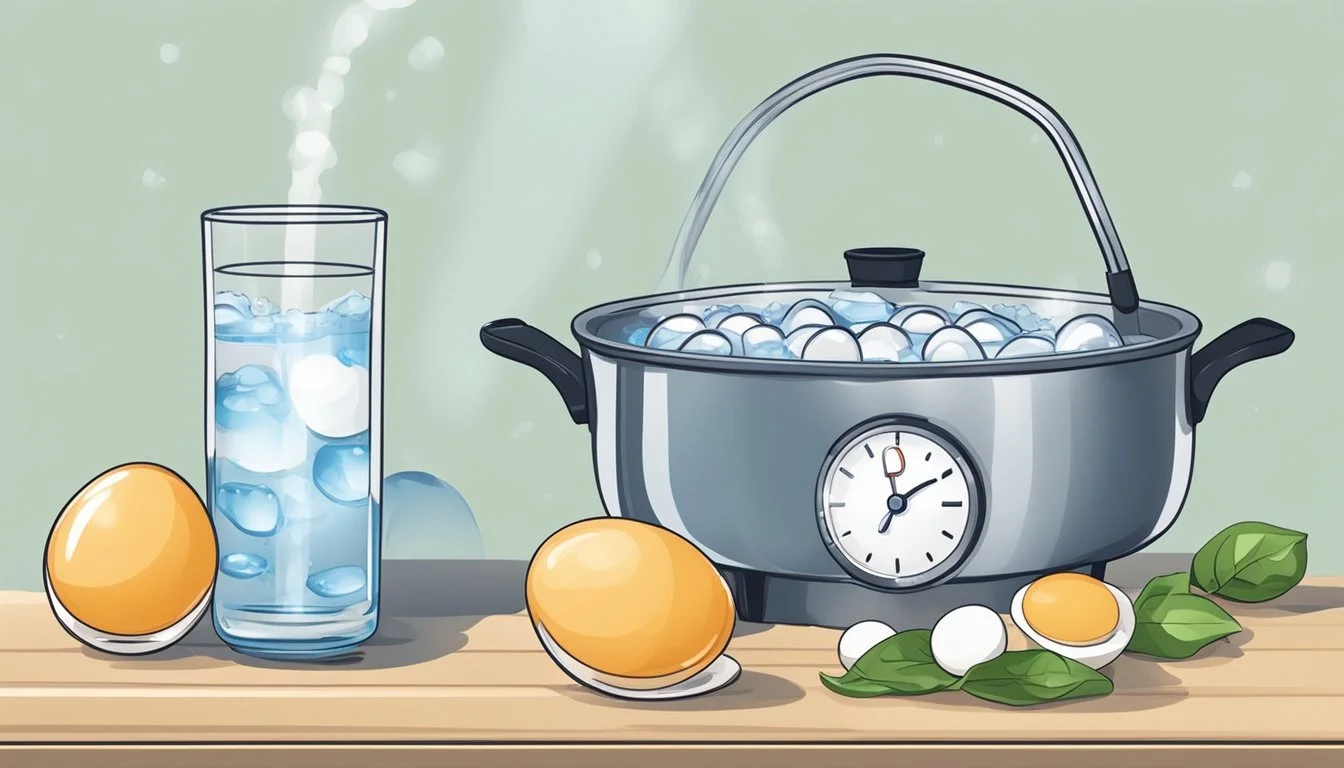Saving Overcooked Hard-Boiled Eggs
Tips for Achieving Creamy Yolks Every Time
Hard-boiled eggs are a kitchen staple, known for their ease, nutrition and versatility. However, even the simplest of cooking tasks can sometimes go awry, leading to overcooked eggs characterized by a chalky yolk and a sulfuric odor. The disappointment of an overcooked egg can be significant, especially when perfect creaminess is expected. It may seem that all is lost once the eggs have reached this stage, but there are several techniques to salvage them and achieve a creamy yolk texture.
Savvy cooks have developed methods to mitigate overcooking and rescue their hard-boiled eggs from the brink. Understanding the egg's reaction to heat is key: when eggs are cooked for too long, the proteins in the egg whites and yolks bind tightly, squeezing out moisture. This results in the telltale signs of rubbery whites and crumbly yolks. To counteract this, one can introduce moisture back into the yolk or even repurpose the overcooked eggs into dishes where texture is less critical.
The goal is to ensure that every hard-boiled egg serves its purpose, whether it is intended to be the star of a salad, a component in deviled eggs, or simply a quick snack. With deliberate steps, overlooked eggs can be given a second chance. This not only reduces food waste but also ensures a satisfying eating experience.
Selecting the Best Eggs
When aiming for the perfect hard-boiled egg, selecting the right eggs is crucial. The age of the egg and its origin play significant roles in the egg's behavior during cooking and the quality of the final product.
Egg Freshness and Age
The age of an egg is a critical factor when boiling. Older eggs tend to peel more easily after boiling, as the pH of their whites increases over time, causing them to adhere less to the membrane. Fresh eggs may be harder to peel, but they can still produce firm whites and creamy yolks if cooked correctly. A suggested technique for assessing egg age is to place them in water; older eggs will often float while fresher eggs will sink.
Farm-Fresh Versus Store-Bought Eggs
Comparing farm-fresh and store-bought eggs can influence the outcome of hard-boiled eggs. Farm-fresh eggs are often perceived as more flavorful and may come from better-sustained environments. They are typically fresher but could be more challenging to peel due to a lower pH in the whites. Store-bought eggs, by contrast, are usually several days old by the time they reach the consumer, which inadvertently may make them a better choice for hard-boiling due to the ease of peeling. Regardless, both can achieve a desirable texture with the right cooking method.
Preparation Before Boiling
Achieving perfectly boiled eggs begins with crucial steps before the eggs even touch the water. By starting with the right preparation, one can avoid the disappointment of overcooked eggs, ensuring a creamy yolk each time.
Room Temperature Eggs
It is essential to start with eggs that are at room temperature as they are less likely to crack when introduced to boiling water. If one stores eggs in the refrigerator, they should take them out 30 minutes before boiling. This gradual temperature adjustment reduces the temperature shock that can cause cracking during cooking.
Adding Ingredients for Easy Peeling
Utilizing certain ingredients in the boiling water can aid in the peeling process of hard-boiled eggs. Two common household items for this are:
Baking Soda: Adding about 1/2 teaspoon of baking soda to the boiling water can make the eggs easier to peel by increasing the alkalinity of the water, which in turn causes the egg white to separate from the shell more easily.
Vinegar: A splash of vinegar (approximately 1 tablespoon) to the boiling water helps in case the eggs do crack; the vinegar can assist in coagulating the egg whites more rapidly, preventing them from leaking out.
Boiling Eggs to Perfection
The key to perfect hard-boiled eggs lies in precise timing and understanding the stages of doneness. Achieving the ideal texture of both whites and yolks requires paying close attention to how long the eggs boil.
Timing Your Boil
To start, place eggs in a saucepan and cover them with cold water, ensuring there is about an inch of water above the eggs. This aids in heating the eggs gently to avoid cracking. Bring the water to a rolling boil over high heat. Once a rolling boil is reached, setting a timer is crucial for consistency. For perfect hard-boiled eggs, one should typically boil the eggs for 9-12 minutes.
Boil Duration Egg Doneness 4-5 minutes Soft-boiled eggs 6-7 minutes Medium-boiled eggs 9-12 minutes Hard-boiled eggs
After boiling, the eggs should be promptly placed in an ice bath to halt further cooking. This also makes peeling easier.
Achieving the Perfect Doneness
The desired doneness for hard-boiled eggs is a fully set, non-rubbery white and a firm, bright yellow yolk without a green ring—an indication of overcooking. To achieve this, one must boil the eggs and then remove them from the heat, covering the pan, to let them cook in the residual heat for the remainder of the time.
For Soft-boiled eggs: Boil for 4-5 minutes. For Medium-boiled eggs: Boil for 6-7 minutes. For Hard-boiled eggs: Boil for 9-12 minutes, depending on the size of the eggs and starting temperature.
It's important to note that once boiled and cooled, hard-boiled eggs can last in the refrigerator for about a week if kept in their shells. The precise timing, along with proper cooling, ensures the perfect doneness and longevity of hard-boiled eggs.
Immediate Post-Boiling Steps
Ensuring the perfect texture of hard-boiled eggs and ease of peeling relies on taking the right steps immediately after boiling. Proper cooling not only helps in getting a creamy yolk but also leads to effortless peeling.
Ice Bath for Easy Peeling
Once the cooking is complete, transferring the eggs to an ice bath is essential. To do this effectively:
Fill a large bowl with equal parts ice and water.
Use a slotted spoon to gently place the eggs into the ice bath.
Let them sit for at least 10 minutes.
An ice bath halts the cooking process, preventing the yolks from overcooking and creating a temperature shock, which causes the eggs to contract slightly in their shells, making them easier to peel.
Peeling Techniques
For easy peeling, the following techniques can be utilized:
Rolling: Gently roll the egg on a hard surface to crack the shell uniformly.
Peeling Under Water: Peel the eggs under cold water. The water helps to separate the egg from the shell.
Starting at the Wide End: Begin peeling from the wider end of the egg, which often has an air pocket.
Using these methods directly after the eggs have cooled in an ice bath ensures the shell comes away cleanly, leaving a smooth surface on the egg.
Alternative Cooking Methods
Exploring alternative cooking methods can allow for more precise control over the cooking process and might prevent overcooking, leading to creamier yolks in your hard-boiled eggs. Let's examine two popular methods: using an Instant Pot and comparing traditional stovetop to pressure cooker techniques.
Instant Pot Hard-Boiled Eggs
The Instant Pot method streamlines the cooking process using a pressure cooker function which can produce consistently easy-to-peel eggs. The basic steps are to add water to the Instant Pot, place eggs on the trivet, then select the "Manual" or "Pressure Cook" setting typically for about 5 minutes, followed by a 5-minute natural release and then a quick release. Finally, one should place the eggs in an ice bath to halt the cooking process.
Stovetop Versus Pressure Cooker
When comparing hard-boiled eggs made on the stovetop to those in a pressure cooker, one must consider the differences in cooking times and water quantities.
Stovetop Method:
Eggs are submerged in water and brought to a boil, then simmered or left in hot water off the heat.
Water quantity: Enough to cover the eggs by an inch.
Timing: Bring to a boil then either turn off heat and let stand (for 9-12 minutes depending on desired firmness), or continue to simmer for the same duration.
Pressure Cooker Method:
Eggs are placed on a trivet above water and cooked under pressure, not submerged.
Water quantity: Only 1 cup, as the steam pressure cooks the eggs.
Timing: Typically 5 minutes at high pressure with a 5-minute natural release, then a quick release.
The pressure cooker, particularly the Instant Pot, offers an efficient and consistent method with less water and quicker cooking times when compared to the stovetop. This method has gained popularity for its convenience and reliability.
Preventing and Fixing Overcooked Eggs
Achieving the perfect hard-boiled egg with creamy yolks can be a precise task, but with proper techniques, one can prevent and even fix overcooked eggs to a certain degree.
Identifying Overcooked Eggs
An overcooked hard-boiled egg is typically easy to spot. The common signs include:
Whites: Firm or rubbery texture.
Yolk: Crumbly and dry, with a gray-green ring around it due to a reaction between sulfur and iron.
Restoration Techniques for Creamy Yolks
For eggs that have gone slightly beyond the ideal cooking time, certain restoration techniques can help improve their texture:
Crumbly Yolks: Halve the eggs and scoop out the yolks. Mash them to a fine crumbly consistency before mixing with ingredients that can moisten, like mayonnaise for making egg salad or deviled eggs.
Adding Creaminess: Stirring in a small amount of cold cream can reintroduce moisture into the dry yolk, helping to bring it closer to the desired creamy consistency.
Remember, these techniques may not entirely revert the yolk to its original creamy state, but they can improve the overall texture and flavor of overcooked eggs.
Recipe Ideas for Hard-Boiled Eggs
Utilizing overcooked hard-boiled eggs doesn't have to be a culinary disappointment. The following recipes transform them into delectable dishes, highlighting their firm whites and creamy yolks as essential ingredients.
Classic Deviled Eggs
A timeless favorite, deviled eggs are a versatile addition to any gathering. Ingredients typically include mayonnaise, mustard, and a sprinkling of paprika. One begins by halving the eggs, removing the yolks, and combining them with the other ingredients before refilling the whites. The standard cook time for the yolk mixture is minimal, as most preparation involves assembly. For an intriguing twist, try avocado deviled eggs, incorporating ripe avocado for a creamy texture and a pop of color.
Egg Salad Variations
Egg salad is a quick solution for repurposing hard-boiled eggs into a protein-packed snack or sandwich filling. Mash the eggs and mix with mayonnaise, diced celery, and fresh herbs. For an inventive take, add curry powder for a bold flavor or chopped pickles for tanginess. Egg salad's adaptability makes it suitable for various diets, and it's perfect spread on a slice of toast or nestled in a bed of greens.
Inventive Breakfast Options
For breakfast enthusiasts, hard-boiled eggs can enhance the first meal of the day. Chopped eggs can be sprinkled over avocado toast, adding a satisfying protein boost. Another innovative idea is to slice eggs and layer them in breakfast sandwiches for a hearty option on the go. Last, one might also consider incorporating them into a deviled egg potato salad for a brunch side dish that's both filling and flavorful. Each of these choices promises a good start to the day with a satisfying blend of protein and taste.
Storing Hard-Boiled Eggs
Successful storage of hard-boiled eggs is crucial for maintaining their freshness and quality, ensuring that they are safe to eat and enjoyable in consistency, ranging from firm to very firm yolks.
Refrigeration Best Practices
Refrigerator Placement: Hard-boiled eggs should be kept on the middle shelf of the refrigerator. This is where the temperature is most consistent. Eggs must be stored in an airtight container or resealable bag to shield them from absorbing strong odors and to prevent the entry of harmful microorganisms.
Peeling: It is advised to store hard-boiled eggs unpeeled as the shell offers a natural barrier against bacteria and moisture loss. If eggs are peeled, they should be kept in a bowl of cold water, which must be changed daily, enhancing longevity.
Longevity and Usability
Shelf Life: Unpeeled hard-boiled eggs can be refrigerated for up to one week. Once peeled, eggs should be consumed within two to three days for optimal quality.
Relevance for Overcooked Eggs: Even if eggs are overcooked, proper storage in the refrigerator can help preserve their usability, albeit with a change in texture causing a firmer yolk. Sealed and refrigerated, they remain a versatile ingredient for numerous dishes.
Nutrition and Health Benefits
Hard-boiled eggs are a robust source of nutrition packed into a small package, providing essential proteins and a variety of nutrients beneficial to one's diet. They can be seamlessly integrated into meals, serving as a protein-packed snack or an ingredient in diverse egg recipes.
Protein Content
One large hard-boiled egg contains 6.3 grams of protein, which is vital for muscle repair, immune function, and the overall maintenance of healthy tissues in the body. Given that adults need approximately 50 to 175 grams of protein daily, incorporating hard-boiled eggs into a diet is an effective way to meet this requirement.
Incorporating into Diets
Hard-boiled eggs can be easily added to various diets, and their versatility makes them an excellent ingredient in numerous dishes. They can be:
Sliced into salads for a nutritious uplift,
Mashed into sandwich fillings for a satisfying meal,
Or simply eaten alone as a protein-packed snack.
Each method offers a convenient way to enjoy the healthy benefits of eggs while keeping meals interesting and varied.
Tips and Tricks for Perfect Eggs
Getting the perfectly cooked hard-boiled egg involves more than just timing; one needs the right tools and an understanding of common pitfalls. Here's how to achieve creamy yolks and avoid overcooking.
Egg-Cooking Accessories
To cook eggs, a saucepan large enough to hold them in a single layer is ideal. One should also have a slotted spoon to carefully place and remove the eggs from hot water. For soft boiled eggs, which require a shorter cooking time of about 6-7 minutes, having a timer on hand ensures precision.
Timer: Essential for tracking exact cooking durations.
Saucepan: Choose one with a heavy bottom for even heat distribution.
Slotted Spoon: Allows safe egg transfer while draining hot water.
Trivet for Instant Pot (Optional): Useful for pressure cooking eggs.
Troubleshooting Common Issues
Boiling Eggs: Begin with cold water, then bring it to a boil. This helps to prevent eggs from cracking due to shock from temperature changes. For hard-boiled eggs, once the water reaches a rolling boil, reduce the heat to a simmer for 10-12 minutes.
Cracked Eggs: Lower eggs gently into the water with a spoon to avoid cracking.
Overcooking: Remove saucepan from heat and transfer eggs to a bowl of cold water immediately after the recommended time to stop the cooking process.
Peeling Difficulty: Fresh eggs can be hard to peel, so it's advisable to use eggs that are a few days old. Cooling eggs in cold water after boiling makes peeling easier.
By following these tips and using the recommended accessories, one can consistently achieve perfectly cooked eggs with creamy yolks.
Seasonal and Cultural Significance
Hard-boiled eggs are not only a staple ingredient in many recipes, but they also hold significant cultural and seasonal importance. They are particularly emblematic of Easter traditions and featured in various global dishes.
Easter Traditions
During Easter, eggs symbolize new life and resurrection. Hard-boiled eggs are a central component of the Easter celebration in many cultures. Families commonly dye or paint them, which are then used in Easter egg hunts or given as gifts. The use of eggs in Easter is deeply intertwined with Christian traditions, and the practice of decorating eggs dates back centuries. Eggs are often incorporated into festive meals, with the preferred consistency of the yolk varying according to regional and familial tastes.
Global Egg Dishes
Eggs are a universal ingredient found in countless dishes around the world.
China: In China, tea eggs, marbled with rich colors and savory flavors, are a popular snack. Overcooked yolks are less of an issue as the eggs are valued for their firm texture and the spices they're steeped in.
Middle East: Countries in the Middle East often use hard-boiled eggs in various dishes. For example, they're an essential part of the Jewish Passover meal, known as Seder, representing sacrifice and mourning.
Each region has its own method of incorporating eggs into meals, but commonly the focus is on achieving the perfect balance between a tender white and a creamy yolk to enhance the overall dish.
Conclusion
Achieving the perfect hard-boiled egg is a balance of timing, temperature, and technique. One must remember that overcooking is the primary cause of rubbery whites and grey-green yolks. To avoid this:
Start with eggs at room temperature to promote even cooking.
Use a timer to prevent eggs from cooking longer than necessary.
For eggs with creamy yolks, boil for 6-7 minutes over medium-high heat.
Immediately cool the eggs in ice water to halt the cooking process.
Should one find themselves with overcooked eggs, they can still be salvaged for many uses:
Chop them for salads or sandwich fillings.
Mash them with seasonings for a savory spread.
The key takeaway is that hard-boiled eggs need not be difficult. With these guidelines, one can consistently produce eggs with a creamy yolk and tender white. Through understanding the science of eggs and embracing proper technique, the outcome will be delightful. Finally, experimentation and attentive cooking are one's best assets in mastering the art of hard-boiled eggs.










